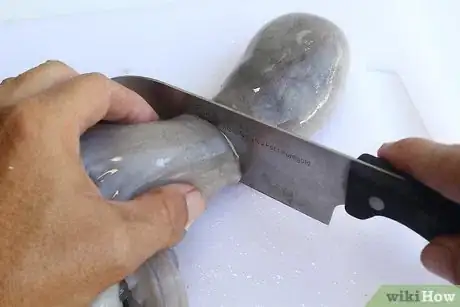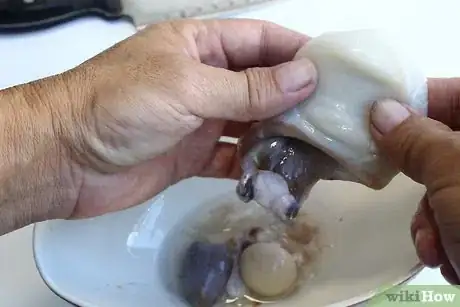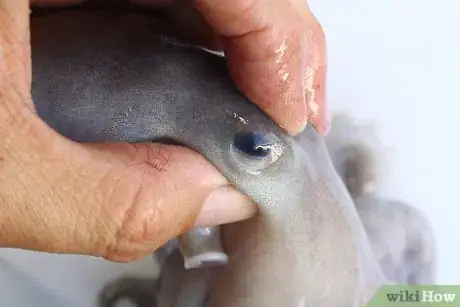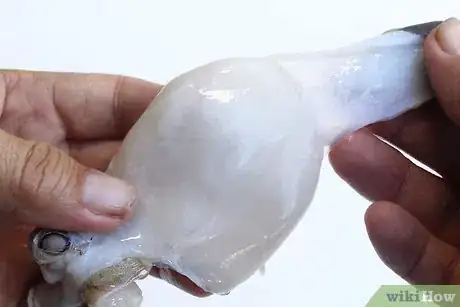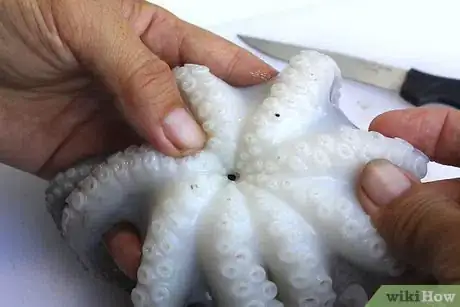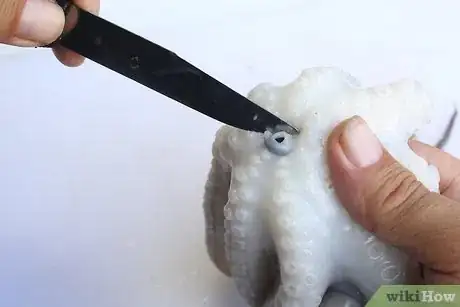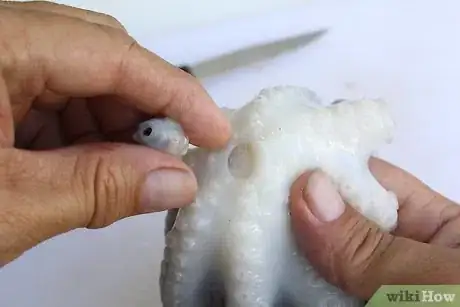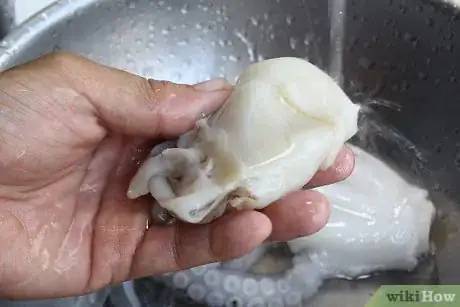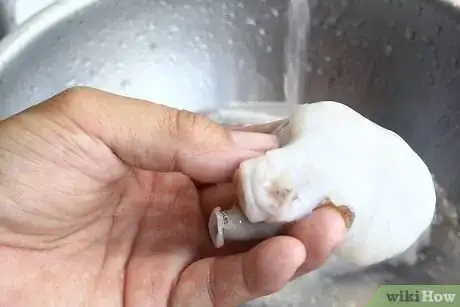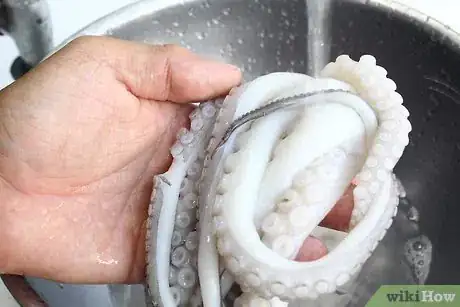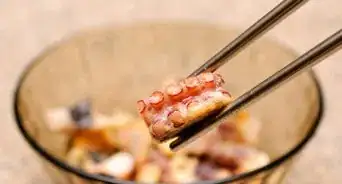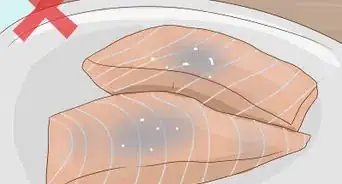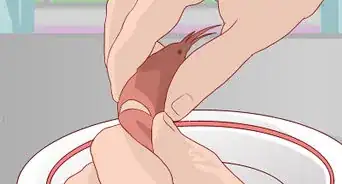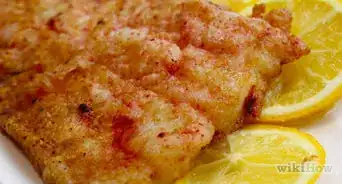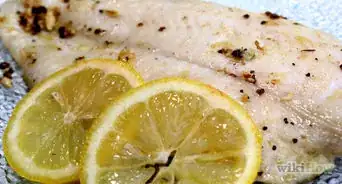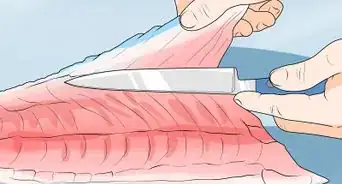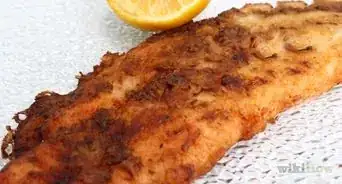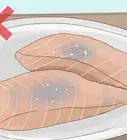This article was co-authored by wikiHow Staff. Our trained team of editors and researchers validate articles for accuracy and comprehensiveness. wikiHow's Content Management Team carefully monitors the work from our editorial staff to ensure that each article is backed by trusted research and meets our high quality standards.
There are 8 references cited in this article, which can be found at the bottom of the page.
This article has been viewed 77,936 times.
Learn more...
Cleaning an octopus is the first step to making exquisite seafood dishes in your own home. Although you can buy pre-cleaned frozen octopus, some fresh octopus is sold without being cleaned. Cleaning an octopus involves removing the internal organs, skin, and beak, leaving the tentacles and body for cooking.
Steps
Cleaning the Head
-
1Slice off the head if you won't be using it. Cut a firm, straight line just below the eyes through the flesh. A sharp knife or kitchen shears work best.[1]
-
2Dispose of the internal organs if you want to keep the head. Slice through the head membrane at the base, to create a pocket-type structure with the flesh. Turn the pocket inside out, exposing the entrails and internal organs. Pull all of the innards away using your hands, and cut through any membranes.[2]
- The internal organs include the stomach sac, which is around the size of an avocado stone, the pipe structure, and many loose membranes. When all of the innards are removed, the head will be empty and look like a hat.[3]
- You will be left with an empty, pocket type structure. Flip it back the right way around to continue.[4]
Advertisement -
3
-
4Remove the skin. Use a knife to make a small incision into the outer membrane. You can then easily peel the skin away using your fingers.[7]
Removing the Beak
-
1Spread the tentacles to locate the beak. The beak is found amid the start of the tentacles. It is black and looks similar to a bird’s beak.[8]
- The beak is used by the octopus for predation, and is similar in structure to a fingernail. It is solid, muscular, and inedible; not something you want to find in your dish![9]
-
2Slice around the base of the beak. Use a paring knife to make a full circular cut around the beak. This will allow it to pop out cleanly.[10]
-
3Push the beak out. Firmly press the soft surrounds of the beak using your thumbs. This will push it through to the other side so that it can be disposed.[11]
Rinsing
-
1Hold the octopus under cold running water. If the head is still attached, begin with it flipped inside out to make sure that any remaining entrails are washed away. Then turn the head back the right way around to rinse off the outside.[12]
- It can help to have a large bucket in the sink when you are rinsing the octopus, as the process can get slippery.
-
2Flush the eye sockets. Run each empty socket under the cold water. This will ensure that any remaining loose pieces are removed.[13]
-
3Rinse the tentacles. Hold each tentacle under running water in turn. Pay special attention to the suckers on the tentacles, making sure they are thoroughly washed out with water.[14]
Warnings
- Fresh octopus should smell slightly salty and of the ocean. If it has a strong, fishy smell, this means that it has started to spoil.[16]⧼thumbs_response⧽
References
- ↑ https://www.sbs.com.au/food/recipes/pickled-octopus
- ↑ https://www.italyum.com/tips/32-octopus-preparation.html
- ↑ https://www.italyum.com/tips/32-octopus-preparation.html
- ↑ https://www.italyum.com/tips/32-octopus-preparation.html
- ↑ https://www.italyum.com/tips/32-octopus-preparation.html
- ↑ http://www.fishfiles.com.au/Preparing-seafood/How-to-guides/How-to-prepare-squid-cuttlefish-and-octopus
- ↑ http://www.fishfiles.com.au/Preparing-seafood/How-to-guides/How-to-prepare-squid-cuttlefish-and-octopus
- ↑ https://www.finecooking.com/article/cook-octopus-home
- ↑ https://oceantoday.noaa.gov/howtofeedagiantoctopus/
- ↑ https://www.bonappetit.com/test-kitchen/how-to/article/guide-to-octopus
- ↑ https://www.bonappetit.com/test-kitchen/how-to/article/guide-to-octopus
- ↑ https://www.theguardian.com/lifeandstyle/2004/mar/14/foodanddrink.shopping3
- ↑ https://www.italyum.com/tips/32-octopus-preparation.html
- ↑ https://www.italyum.com/tips/32-octopus-preparation.html
- ↑ https://www.bonappetit.com/test-kitchen/how-to/article/guide-to-octopus
- ↑ https://www.thekitchn.com/ingredient-spotlight-octopus-98259
